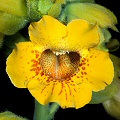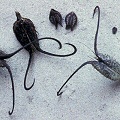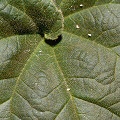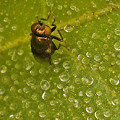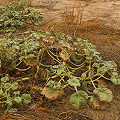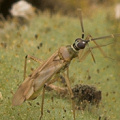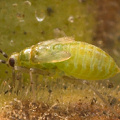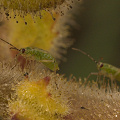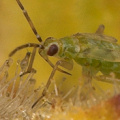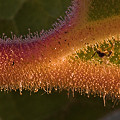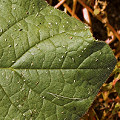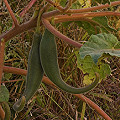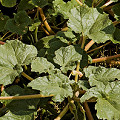Q: What are the genera Ibicella and Proboscidea like?
A: Ibicella lutea is a South American plant that has
naturalized and become a weed in many
countries. It and similar genera are widely known as "devil's claws" or
"unicorn plants" because of the characteristic shape of the seed pods.
It has been suggested it is carnivorous in a manner similar to Pinguicula,
that is via glandular leaves. I have grown this plant to flower a number of times,
and while I could see insects being captured by the leaves I was not impressed.
Furthermore, I have tested this plant for digestive enzymes using the
simple film-emulsion test and have found absolutely no indication of
enzyme production.
In a nutshell, there is no truly compelling evidence that this is anything other than just another
sticky plant.
Yet, the world is full of interesting surprises. I have been studying two populations
of Ibicella lutea in California (where the plant is not native) and have observed
Hemipteran bugs crawling on the plants. One, Cyrtopeltis modestus, is much like
the Pameridea bugs that live on Roridula
(and facilitate that plant's carnivory). Cyrtopeltis modestus and
Pameridea both feed on plant saps as well as other insects, for example. Could these insects
be facilitating carnivory in Ibicella lutea?
An interesting feature of this plant is that the stigmatic surface moves upon stimulation, so it swings up and out of
the way. Clearly this is an adaptation to ensure that visiting pollinators can deposit pollen on the stigma, but
then cannot accidentally apply pollen picked up from the same flower.
It is also interesting that the huge claws are clearly adapted to hook onto large animals to be dispersed. The claws are
so sharp that cattle can be damaged by it. Such wounds, though, are certainly not enough to kill them, so the story you sometimes
hear, that the plants live on soils enriched by the cattle they kill, is really quite silly. It is far more interesting to think
how these claws evolved to be carried by now-extinct megafauna such as mammoths and gomphotheriums!
Another cool dispersal mechanism for this plant is that when the fruit ripen, seeds tumble easily out to the ground, ensuring new
plants can emerge from the same site the next year. Meanwhile another row of seeds are locked in the tissue of the woody fruit, and
only are freed when the fruit decays. Presumably, this happens only after a long time, and in this time the fruit could be
carried a long way by large mammals. Short range and long range seed dispersal by the same fruit!
Cultivation is easy. Treat Ibicella plants as a somewhat
dry-soil garden plant. Give it full sun and lots of warmth. Osmocote does not seem to be deadly to it.
Warm conditions are required for germination, and many seedlings die from
damping off (a fungal infection). Perhaps the only challenge they will
present is that they like a long growing season. If your season is too short,
they will not produce mature fruit. In some areas, such as Western Australia, the plant is considered
a noxious weed because the claws can wound livestock. Check the noxious weed laws to make sure that the
plant is not illegal to grow!
Proboscidea is a closely related genus; in fact many people confuse them; most
"Ibicella" plants in cultivation are really Proboscidea.
The plants in this genus of plants, like Ibicella, have large fruit and sticky leaves. The leaves of
plants in the wild are frequently covered with dead bugs, but there is no indication they
are being absorbed by the plant. So there is no evidence this genus is carnivorous.
Page citations: Rice, B.A. 1999, 2006a, 2008a; Van Eseltine, G.P. 1929.
